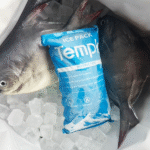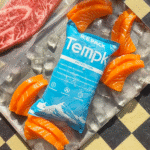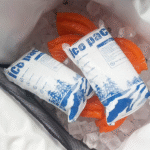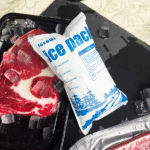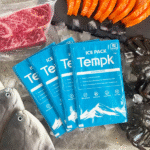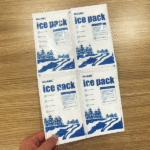Dry ice pellets and Trockeneis-Packblätter are at the heart of modern frozen shipping. Diese ultrakalten Wirkstoffe sorgen für Impfstoffe, Fleisch, and biological samples travel safely from factory to destination. In 2025 the dry ice market faces supply pressures and sustainability demands yet continues to grow rapidly; global consumption is rising around 5 % a year while CO₂ supply increases at only 0.5 %, causing periodic price surges. This guide explains how dry ice pellets and pack sheets work, how to choose the right format for your needs, and how to handle and store them safely. You’ll learn best practices, Kostenüberlegungen, and emerging technologies such as hybrid systems, Smart Sensoren, and carbon captured dry ice production—all using clear language and practical examples.
What makes dry ice pellets and dry ice pack sheets different? Learn the science behind pellets and sheets and how each format affects cooling speed, duration and handling.
When should you choose pellets versus pack sheets? Discover scenario based guidelines for pharmaceuticals, Fleisch, biotech and food shipping.
Wie viel Trockeneis sollten Sie verwenden?? Use practical formulas and tables to calculate pellet weight or sheet count based on transit time and container volume.
What safety and regulatory rules apply in 2025? Gefahrenkennzeichnungen verstehen, Und 1845 Markierung, venting requirements and IATA limits.
Which innovations are shaping the dry ice industry? Erkunden 2025 trends like CO₂ capture, automated pelletizers, reusable sheets, hybrid PCM systems and smart sensors.
How can you optimize cost and sustainability? Learn strategies to stretch each kilogram of dry ice, reduce waste and adopt greener alternatives.
Understanding Dry Ice Pellets and Pack Sheets
Trockeneis ist festes Kohlendioxid (Co₂). At –78.5 °C (–109 °F) it is colder than water ice, and it sublimates—turns directly from solid to gas—without leaving liquid behind. Two principal formats dominate cold chain logistics: pellets and pack sheets.
What Are Dry Ice Pellets?
Dry ice pellets are small cylindrical pieces of solid CO₂. Each pellet is typically 3–16 mm in diameter and has a high surface area relative to its mass. This geometry allows rapid heat absorption and intense cooling. When placed inside insulated boxes, pellets create a quick temperature drop to –78.5 °C, freezing the payload and preventing thawing. Pellets are often used in pharmaceutical shipping, biotech sample transport and industrial cleaning due to their fast cooling and precise temperature control. The table below contrasts pellets with other cooling methods:
| Kühlmethode | Temperaturbereich | Dauer | Ideale Anwendung | Praktischer Nutzen |
| Trockeneispellets | –78,5 °C | 24–48 Stunden | Ultra cold shipping | Keine Flüssigkeitsrückstände; Schnelle Kühlung |
| Trockeneisbeutel | –40 °C bis –60 °C | 36–72 Stunden | Medium temperature shipments | Wiederverwendbar, langsamere Sublimation |
| Gelpackungen | 0 °C bis –20 °C | 12–24 Stunden | Transport verderblicher Lebensmittel | Budget friendly; wiederverwendbar |
| Phasenwechselmaterial (PCM) | Anpassbar | 24–96 Stunden | Biopharmazeutische oder diagnostische Kits | Stabile Temperaturbänder |
Pellets are single use and require personal protective equipment (PS) such as insulated gloves and goggles because direct contact can cause frostbite. Their rapid sublimation also means you need adequate ventilation to avoid CO₂ buildup. In transit they typically last 24–48 hours depending on insulation quality and external temperatures.
Was sind Trockeneis-Packblätter??
Trockeneis-Packblätter (also called dry ice sheets) are flexible panels filled with dry ice pellets or CO₂ snow encased in durable plastic or woven fabric. They are engineered to provide steady, extended cooling up to 72 Std.. Im Gegensatz zu losen Pellets, sheets minimize vapor release and can be reused multiple times, reducing waste and handling risks. Pack sheets often incorporate pockets or cells that house pellets; wenn gefroren, they form a rigid panel that fits neatly around or above your product, preventing movement and ensuring uniform temperature.
Key advantages of pack sheets include:
Verlängerte Kühldauer – Many pack sheets maintain a stable temperature up to 72 Std..
No direct contact risk – The pellets are sealed inside, reducing CO₂ exposure and frostbite risk.
Wiederverwendbares Design – High quality sheets can be refrozen and reused, cutting packaging waste and cost.
Anpassbare Größen – Sheets are available in various cell counts (Z.B., 24Zelle, 48Zelle) and can be cut to fit different containers.
Because pack sheets cool gradually, they are well suited for mid temperature shipments such as frozen meat, Meeresfrüchte, and biotech samples requiring –20 °C to –60 °C conditions. Businesses often combine pack sheets with pellets to achieve both rapid and sustained cooling.
Choosing Between Pellets and Pack Sheets
The choice between dry ice pellets and pack sheets depends on your product’s temperature sensitivity, Versanddauer, und Handhabungsanforderungen. Use the following guidelines:
Ultra Cold or Flash Freezing: Choose Pellets
Pharmazeutika & Impfungen – Many biologics require –70 °C or lower. Pellets deliver immediate temperature drops; high density pellets in vacuum insulated shippers can keep vaccines stable for 48 Std., Reduzierung des Verderbrisikos durch 40 %.
Cryogenic Samples – Laboratory and biotech samples often need ultra cold storage. Pellets provide precise cooling and easy dosage adjustments.
Industrielle Reinigung – Dry ice blasting uses pellets for cleaning machinery without water residue. Rapid sublimation is essential.
Medium Cold or Extended Transit: Choose Pack Sheets
Fleisch und Meeresfrüchte – Dry ice pack sheets are ideal for long distance meat shipping. They keep meat frozen at –29 °C (–20 °F) without producing meltwater, Erhaltung der Produktqualität. With proper layering, they maintain freezing conditions for 24–48 hours.
Spezialitäten – Frozen desserts, gourmet chocolates or meal kits requiring –20 °C to –40 °C benefit from the controlled release of CO₂. The sealed design prevents cross contamination.
Reusable Logistics – For recurring shipments or closed loop systems, pack sheets minimize waste and handling risks. Their extended life offsets the higher upfront cost.
Hybridkühlung: Combine Both
In 2025 many shippers are adopting hybrid cooling systems combining pellets and pack sheets with phase change materials (PCMs). This approach provides fast cooling to prevent supercooling, then sustained temperatures for extended transit, and reduces overall CO₂ usage. A typical hybrid setup might layer pellets at the bottom for initial flash freezing, pack sheets above the product, and PCM packs to maintain specific temperature bands. This combination can extend hold times by 25 % und reduziert gleichzeitig den Trockeneisverbrauch um 18 %.
Sizing Formulas
To determine how much dry ice you need, Berücksichtigen Sie die Versanddauer, payload volume, and container insulation. For pellets, a common rule is to allocate 5–10 kg of dry ice per 24 hour period per 100 Liter isoliertes Volumen. Für Packblätter, one 24 cell sheet typically provides 8–12 hours of cooling; multiple sheets can extend duration up to 72 Std.. Zum Beispiel:
| Behältervolumen | Recommended Pellet Weight | Sheet Quantity | Erwartete Haltezeit |
| 10 L | 0.75–1 kg | 1 Blatt | ≈ 12 Std. |
| 20 L | 1.5–2.0 kg | 2 Blätter | ≈ 24 Std. |
| 30 L | 2.5–3,0 kg | 3–4 Blatt | ≈ 36 Std. |
| 40 L | 4.0–5.0 kg | 4–5 Blatt | ≈ 48–72 Stunden |
Always pre chill your insulated container and fill empty spaces with dunnage to minimize heat transfer. Pre conditioning reduces sublimation rate by up to 15 %.
How to Pack Dry Ice Pellets & Pack Sheets Safely
1. Vorbereitung & Flüssigkeitszufuhr
If using reusable dry ice sheets, soak them in water before freezing so the cells activate properly. Freeze sheets flat to achieve a uniform shape.
2. Pre Chill Containers
Pre chill your box or cooler using ice packs or by placing it in a freezer for several hours. This lowers the initial thermal shock and slows sublimation.
3. Schichttechnik
Untere Schicht – Place pellets or a pack sheet at the bottom of the insulated container. Pellets provide rapid cooling; sheets ensure steady release.
Pufferschicht – Use cardboard, corrugated plastic or a thin layer of foam to separate dry ice from the product. This prevents direct contact and freezer burn.
Produktplatzierung – Place the product inside, filling void spaces with cushioning materials like bubble wrap or foam inserts. Minimizing voids reduces warm air pockets.
Oberschicht – Add additional pack sheets or pellets above the product to maintain even temperature distribution. Kalte Luftwaschbecken, so having dry ice at the top ensures downward cooling.
Belüftung – Ensure the container has vent holes or breathable insulation. Trockeneis niemals in einer luftdichten Box verschließen; sublimating CO₂ can build pressure and rupture packages.
4. Verpackung & Beschriftung
Clearly label packages with “Dry Ice” or “Carbon Dioxide, Solide,” the UN1845 number, und das Nettogewicht von Trockeneis.
Fügen Sie eine Klasse hinzu 9 hazardous materials label if shipping by air.
Comply with IATA limits: 2.5 kg per package on passenger aircraft and up to 200 kg auf Frachtflügen.
5. Handhabung & PS
Wear insulated gloves and goggles when touching pellets or sheets. CO₂ frost can cause severe skin burns. Do not ingest dry ice or seal it in an airtight container; gas buildup can lead to explosions. Always store dry ice in ventilated areas and keep the storage environment between –80 °C and –20 °C. Rotate inventory using a first in, first out system to avoid using older, sublimated stock.
Kostenüberlegungen & Nachhaltigkeit
Dry ice costs vary widely due to supply constraints. Since CO₂ supply growth (0.5 % pro Jahr) lags behind demand growth (~ 5 % pro Jahr), spot prices can spike by up to 300 % bei Engpässen. Zusätzlich, Der globale Trockeneismarkt wurde mit bewertet $1.54 Milliarden in 2024 und wird voraussichtlich erreicht werden $2.73 Milliarden von 2032 (7.4 % CAGR). To manage costs:
Verpackung optimieren – Use right sized containers and high performance insulation to reduce sublimation and shrink your dry ice requirements.
Mix Cooling Formats – Hybrid packouts using pellets, sheets and PCMs can cut dry ice usage by 18 % bei gleichzeitiger Verbesserung der Temperaturkonsistenz.
Plan Procurement – Secure long term supply contracts or local pelletizer units to avoid price volatility.
Explore Bio CO₂ Sources – Many suppliers now capture CO₂ from bioethanol fermentation or industrial processes, creating a circular loop. Choosing suppliers that use renewable CO₂ helps reduce your carbon footprint and supports sustainable practices.
Nachhaltigkeitsinnovationen
Modern cold chain players are adopting eco friendly measures:
CO₂-Abscheidung & Erholung – Capturing CO₂ from bioethanol or industrial sources reduces reliance on fossil based CO₂ and supports circular economies.
Wiederverwendbare Trockeneisplatten – Durable sheets can be refrozen multiple times, Reduzierung von Abfall und Kosten.
Smart Sensoren & IoT-Tracking – Real time monitoring of CO₂ levels, temperature and sublimation rates helps fine tune cooling and prevent waste.
Hybrid-Packouts – Integrating PCMs and insulated liners reduces CO₂ usage and carbon footprint.
2025 Industry Trends & Markteinsichten
Die Kühlkettenlandschaft entwickelt sich rasant weiter. Zu den wichtigsten Trends gehören:
Market Dynamics & Supply Pressures
The dry ice market faces supply stress due to limited CO₂ availability and high demand. Spot prices have spiked by up to 300 % bei Versorgungsengpässen. Manufacturers are responding by building localized production hubs and on site CO₂ capture to reduce transport losses. Shippers are diversifying cooling strategies—mixing dry ice with PCMs and better insulation—to stretch supply.
Format & Performance Considerations
Selecting the right format (Pellet, Blatt, block or slice) dramatically affects performance. Large blocks sublimate slowly for long shipments; pellets provide rapid cooling but vaporize faster; thin slices offer a balance and fit neatly into packaging. Proper container design—high performance insulation, minimizing void space, and pre conditioning—can reduce sublimation to 3–8 % pro Tag. Mistakes like leaving warm voids or poor venting can compromise product integrity.
Branchenspezifische Trends
Essen & Meat Processing – Thinner pellets and slices allow rapid cooling on processing lines, while blocks remain the format of choice for bulk transport. Better insulated boxes extend hold times and minimize sublimation.
Pharmazeutisch & Labs – New barrier technologies slow CO₂ gas release to prevent supercooling, and real time monitoring helps safeguard payloads. Reusable PCM shippers reduce dry ice consumption.
Industriell & Reinigung – Dry ice blasting contractors secure long term supply contracts and invest in local pelletizing to avoid being deprioritized during shortages.
Innovationen & Zukünftige Anweisungen
Automatisierte Pelletierer – Modern pelletizers produce consistent pellet size, reducing waste and enhancing cooling efficiency.
Wiederverwendbare Trockeneisplatten – New sheets combine the flexibility of packs with the rapid cooling of pellets.
Intelligente Überwachungssensoren – IoT devices track real time CO₂ levels and sublimation rates to optimize replenishment.
Bio Based Packaging – Integrating bio based or recyclable materials in packaging aligns with sustainability goals.
Hybridsysteme – Combining dry ice with PCMs and smart insulation reduces carbon footprint and costs.
Praktische Szenarien & Benutzertipps
Szenario 1: Shipping Frozen Meat Overseas
Herausforderung: A meat exporter needs to ship 20 kg of beef from California to Japan, a 48 hour transit. The cargo must stay below –18 °C.
Lösung: Use four 24 cell dry ice pack sheets layered above and below the beef. Pre chill the EPS container and line it with a PCM pack at –21 °C. Hinzufügen 3 kg of dry ice pellets on top to achieve rapid freezing. Ensure vents allow CO₂ gas to escape. This packout provided 48 hours of stable temperature in trials, with no thawing and 60 % reduction in packaging waste compared with single use pellets.
Szenario 2: Vaccine Distribution During a Supply Crunch
Herausforderung: A pharma company must deliver mRNA vaccines requiring –70 °C conditions. Due to CO₂ shortages, pellet supply is limited.
Lösung: Adopt hybrid cooling: 50 % of the container volume uses dry ice pellets for rapid cooling; the remaining 50 % uses PCMs tuned to –70 °C and reusable pack sheets. Real time monitoring sensors track temperature and sublimation. This method cut pellet usage by 25 % while maintaining regulatory compliance. Long term contracts with local pellet producers ensure priority supply during peaks.
Szenario 3: Artisan Ice Cream Delivery
Herausforderung: A small business ships artisan ice cream across states for 24 Std.. Customer satisfaction hinges on product texture and minimal packaging waste.
Lösung: Use reusable dry ice sheets combined with a single PCM pack at –18 °C. Pre condition the insulated mailer. Because ice cream only needs –15 °C to stay firm, pack sheets provide steady cooling without over freezing, and there is no messy meltwater. Customers returned the sheets in a provided envelope for reuse, reinforcing sustainability values.
Quick Reference Table: Format Selection
| Versandtyp | Recommended Format | Grund | Additional Tip |
| Impfungen & Biologika | High density pellets or hybrid (Pellets + PCM) | Achieves –70 °C quickly and maintains for 48 Std. | Use data loggers to monitor; vent containers appropriately. |
| Fleisch & Meeresfrüchte | Wiederverwendbare Trockeneis-Packblätter | Ensures –29 °C to –40 °C without direct contact | Layer sheets above and below; fill voids to reduce sublimation. |
| Frozen Dessert E commerce | Packblätter + PCM | Provides controlled cooling with minimal frostbite risk | Encourage customers to return sheets for reuse. |
| Industrielle Reinigung & Blast | Kleine Pellets | Provide rapid sublimation and efficient cleaning | Secure long term pellet supply to avoid shortages. |
Sicherheit & Vorschriftenregulierung: 2025 Anforderungen
Trockeneis wird als Gefahrstoff eingestuft (Klasse 9). Compliance ensures worker safety and avoids shipping delays.
UN -Nummer & Etiketten: Kennzeichnen Sie Pakete mit „Trockeneis“ oder „Kohlendioxid“., Solide,Dazu gehört auch die UNO 1845 Nummer, and specify net weight.
Hazard Labels: Affix-Klasse 9 Gefahrenhinweise; this is mandatory for all modes of transport.
Gewichtsbeschränkungen: Adhere to IATA limits—2.5 kg of dry ice for passenger aircraft and up to 200 kg auf Frachtflügen.
Belüftungsanforderungen: Packaging must allow CO₂ gas to escape to prevent pressure buildup.
Dokumentation: Include a bill of lading or safety data sheet if required by the carrier.
PS & Ausbildung: Train staff to handle dry ice using insulated gloves and goggles. Provide emergency procedures for CO₂ exposure, frostbite or container rupture.
Häufig gestellte Fragen
How long do dry ice pellets last?
Pellets typically last 24–48 hours, depending on pellet size, container insulation and ambient temperature. Proper pre conditioning and minimizing void space can extend duration.
Can dry ice sheets replace gel packs?
Ja. Dry ice sheets maintain colder temperatures (–29 °C to –40 °C) for 24–48 hours and leave no meltwater, whereas gel packs only keep temperatures near 0 °C for 12–24 hours. Use sheets when you need sub freezing conditions.
Are dry ice pellets safe for food shipping?
Trockeneis ist bei sachgemäßer Handhabung sicher. Always avoid direct contact with food by placing a buffer layer or using sealed sheets. Vent containers to prevent CO₂ buildup and label packages correctly.
What is the carbon footprint of dry ice?
Traditional dry ice is produced from fossil CO₂. Jedoch, many suppliers now capture CO₂ from bioethanol and industrial processes, Verringerung der Treibhausgasemissionen. Choosing these suppliers supports circular economies.
Wie berechne ich die Menge an benötigtem Trockeneis??
Use about 5–10 kg of dry ice pellets per 24 Stunden pro 100 L Behältervolumen. Für Packblätter, Schätzen Sie ein 24-Zellen-Blatt pro 12 Stunden der Kühlung; adjust based on transit duration.
Welche Alternativen gibt es zu Trockeneis??
Zu den Alternativen gehören Gelpackungen, PCMs and mechanical refrigeration. Gel packs are non hazardous and reusable but only maintain 0 °C to –20 °C for up to 24 Std.. PCMs offer customizable temperature ranges and extended duration, often used in combination with dry ice. Active containers provide refrigeration but are costly and require power.
Kann ich Trockeneisbeutelplatten wiederverwenden??
Ja. High quality pack sheets can be refrozen and reused multiple times, Abfall reduzieren. Inspect for leaks or damage before reuse and follow the same safety guidelines.
Why is venting important?
Als Trockeneis untermauert, CO₂ gas expands significantly. Ohne Entlüftung, pressure can build up and rupture containers. Always ensure vent holes or breathable insulation.
Zusammenfassung & Empfehlungen
Dry ice pellets and dry ice pack sheets are indispensable tools for ultra cold shipping. Pellets provide rapid cooling and precision for pharmaceuticals and industrial applications, while pack sheets offer longer hold times and safer handling for meat and food shipments. In 2025 the dry ice industry faces supply challenges and sustainability pressures, pushing innovation toward hybrid cooling systems, CO₂ capture and smart sensors. To optimize performance and cost:
Wählen Sie das richtige Format – Pellets for quick, ultra cold needs; pack sheets for extended mid range cooling.
Nutzen Sie Hybridlösungen – Combine dry ice with PCMs and high performance insulation to extend duration and reduce CO₂ usage.
Befolgen Sie Best Practices – Pre chill containers, layer properly, ventilate packages and comply with hazard labeling.
Investieren Sie in Nachhaltigkeit – Source dry ice from bio CO₂ suppliers, adopt reusable sheets and integrate smart monitoring.
Plan procurement – Secure supply contracts and local pelletizer options to navigate volatile markets.
Durch Befolgen dieser Richtlinien, you can maintain product integrity, minimize cost and environmental impact, and stay ahead of cold chain innovations.
Über Tempk
Tempk is a global leader in cold chain packaging and thermal control solutions. We specialize in dry ice pellets, pack sheets and advanced insulation technologies that keep your products frozen or chilled from origin to destination. Unser r&D team develops eco friendly materials, smart monitoring devices and hybrid cooling systems to help you meet regulatory requirements and sustainability targets. Contact us for custom guidance on optimizing your cold chain operations.


















